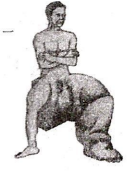 Multiple Choice Questions
Multiple Choice QuestionsWhich one of the following methods is commonly used to maintain the genetic traits of a given plant
By propagating through seed germination
By propagating through vegetative multiplication
By generating hybrids through intergeneric pollination
By treating the seeds with gamma radiations
B.
By propagating through vegetative multiplication
The propagation through vegetative multiplication is used to maintain the genetic traits of a given plant. It gives rise to genetically uniform population or clone. In case of plants propagated through seeds, variations creep in due to chance segregation and recombination of genes during meiosis and their chance combination during fertilisation.
Match the triplet codons listed in column I with their amino acids mentioned in column II and select the correct option from the given codes.
Column I Column II
A. GGG (i) Proline
B. UUU (ii) Glycine
C. CCC (iii) Arginine
D. AAA (iv) Phenylalanine
(v) Lysine
A-(v), B-(iii), C-(i), D-(ii)
A-(v), B-(iii), C-(i), D-(iv)
A-(ii), B-(iv), C-(i), D-(v)
A-(i), B-(ii), C-(iii),D-(iv)
Refer to the given figure depicting a diseased condition in humans and name the worm causing this disease.

Epidermophyton jloccosum
Ascaris lumbricoides
Wuchereria bancrofti
Entamocba histolytica
After double fertilisation, a mature ovule has
I diploid and I haploid cell
1 diploid and I triploid cell
2 haploid and I triploid cell
1 haploid and I triploid cell
A large quantity of urban sewage is drained into nearby village river. Which among the given conditions would happen after mixing of sewage into the river
(i) Biochemical oxygen demand (BOD) of receiving water body increases.
(ii) Dissolved oxygen of receiving water body decreases.
(iii) It will not cause mortality among fishes and other aquatic creatures.
(iv) It will lead to nutrient enrichment of receiving water body.
(i), (ii) and (iii)
(i), (ii) and (iv)
(ii) and (iii) only
(iii) and (iv) only
Which of the following evidences does not favour the Lamarckian concept of inheritance of acquired characters
Absence of limbs in snakes
Melanisation in peppered moth
Presence of webbed toes in aquatic birds
Lack of pigment in cave-dwelling animals
Which one of the following is a correct statement
"Bt" in "Bt-cotton" indicates that it is a genetically modified organism produced through biotechnology.
Classical plant breeding involves fusion of two somatic cells carrying desired genes.
The anticoagulant hirudin is being produced from transgenic Brassica napus seeds.
Golden rice is a transgenic variety of rice rich in vitamin E.
Keystone species deserve protection because these
are capable of surviving in harsh environmental conditions
indicate presence of certain minerals in the soil
have become rare due to overexploitation
play an important role in supporting other species.
Which of the following antibiotics is not correctly matched with the source from which it is obtained
Penicillin Penicillium chrysogenum
Bacitracin Bacillus licheniformis
Griseofulvin Penicillium griseofulvurm
Streptomycin Bacillus griseus
Which of the following statements is correct regarding menstrual cycle
LH induces rupturing of Graafian follicle.
Proliferative phase is characterised by the increased production of progesterone.
Corpus luteum secretes large amount of estrogen.
Both LH and FSH attain a peak level in secretory phase.
